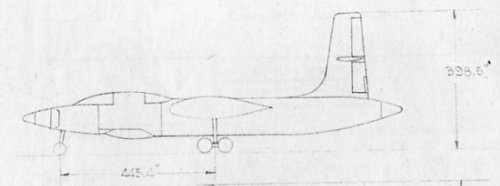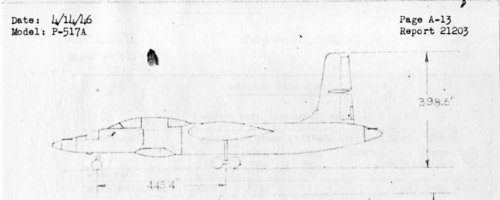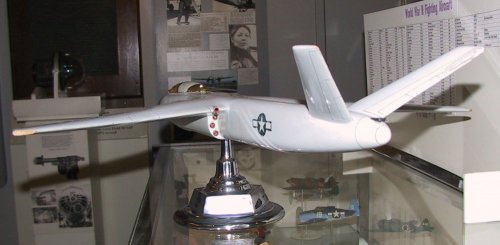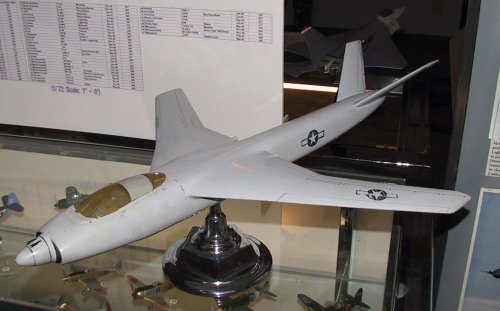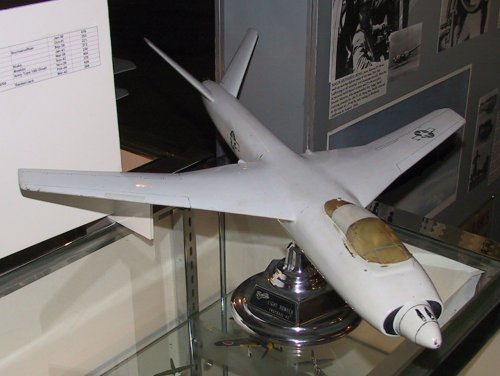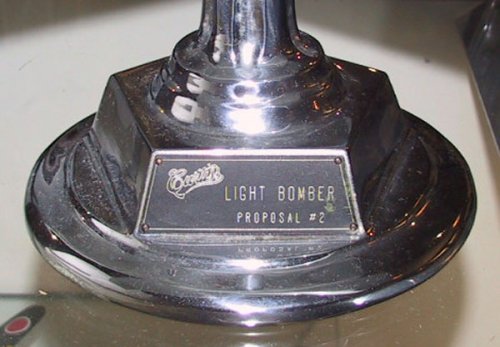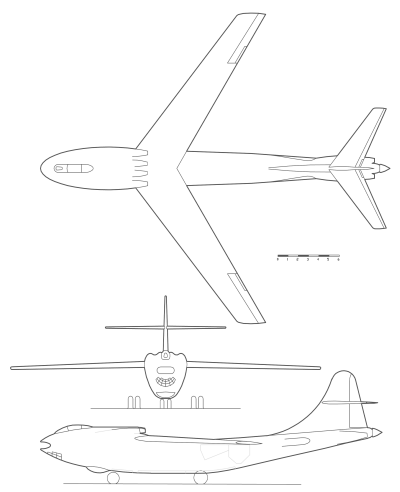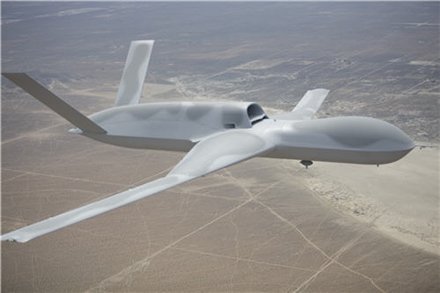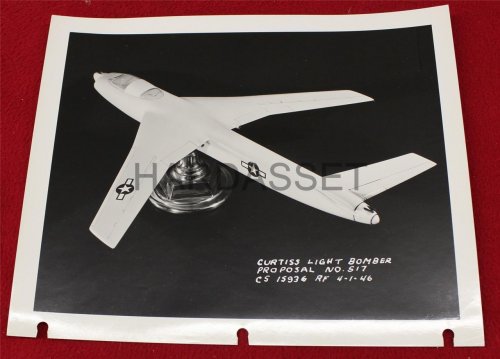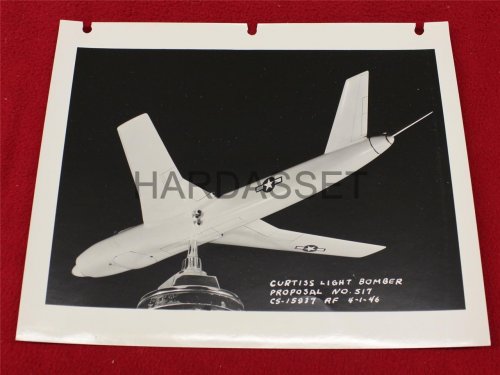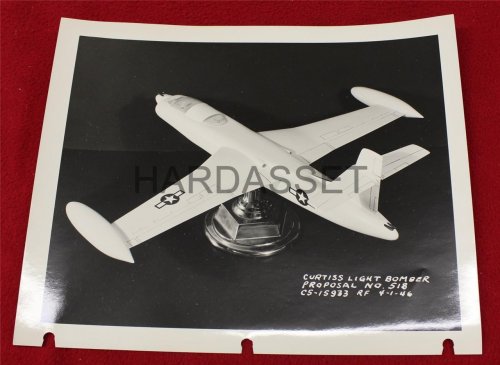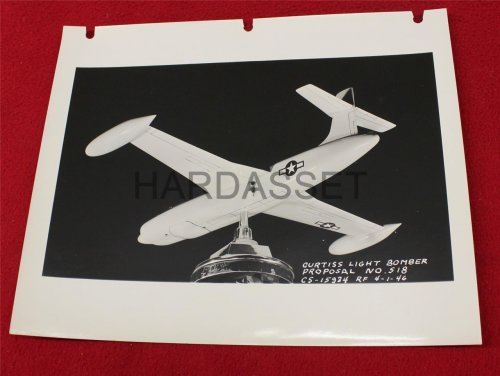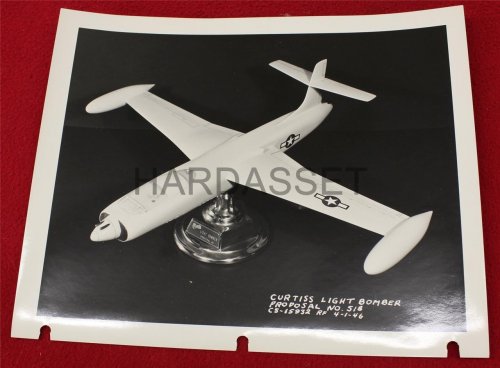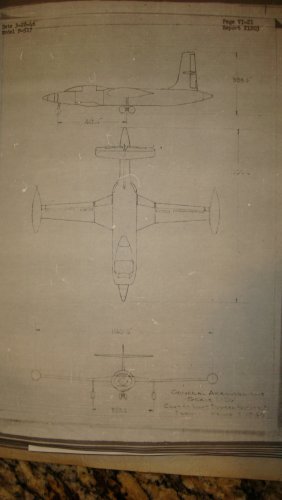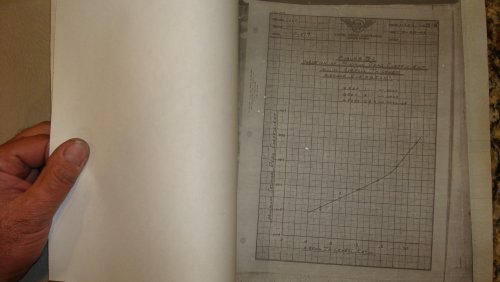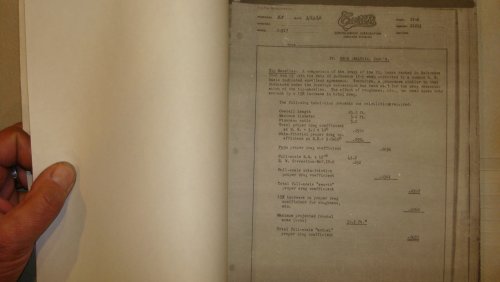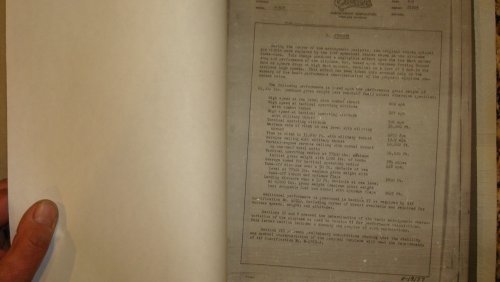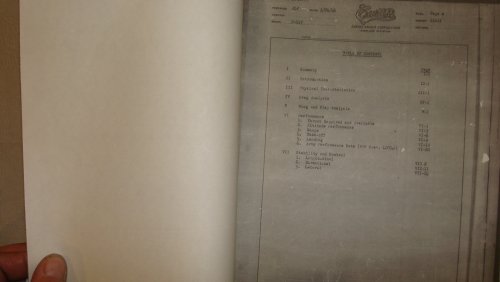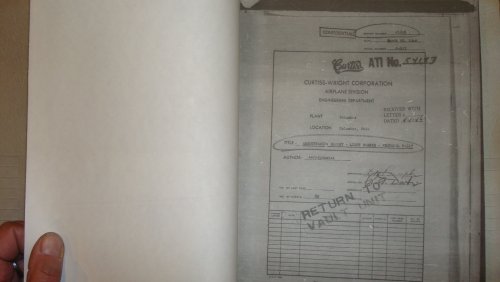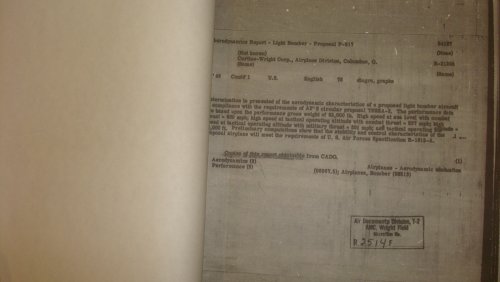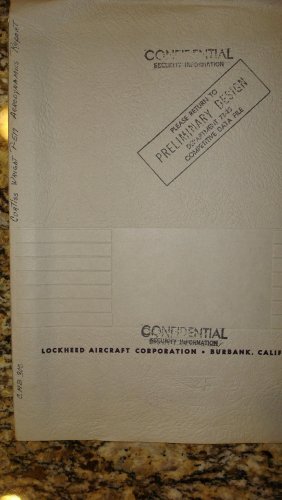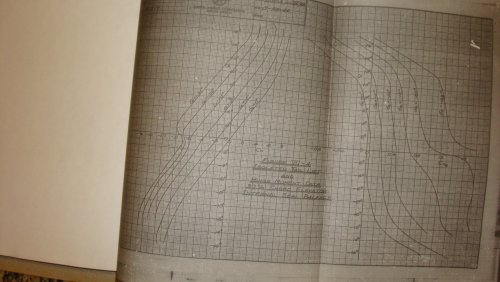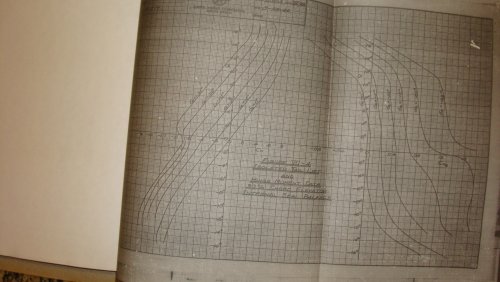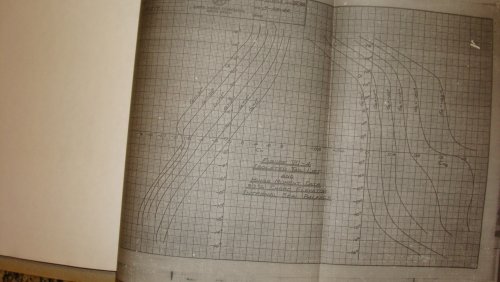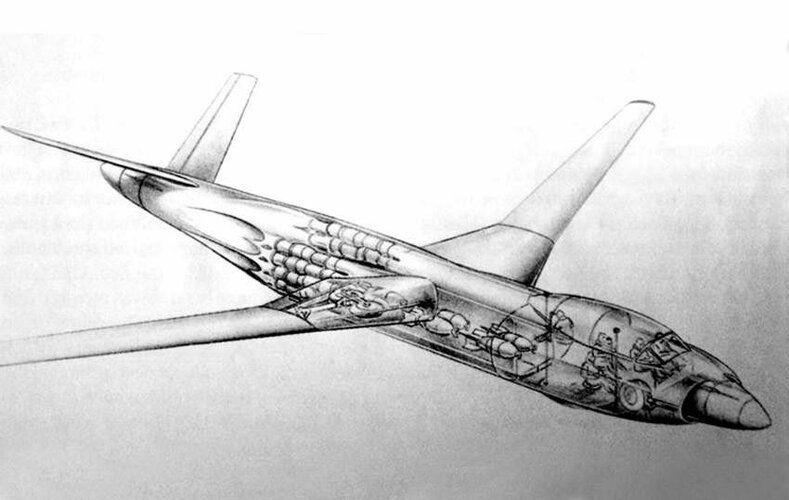You are using an out of date browser. It may not display this or other websites correctly.
You should upgrade or use an alternative browser.
You should upgrade or use an alternative browser.
Curtiss P-517/518 Phantom - 1946 Light Bomber Projects
- Thread starter Antonio
- Start date
Sentinel Chicken
American 71 Heavy, contact departure 126.47
They seem to look a lot like scaled up Blackhawk designs. Any info on the engines and location of the engines?pometablava said:Curtiss Light Bomber Proposal P-517 & P-517A. Report No. 21203. March 30,1946
- Joined
- 13 June 2007
- Messages
- 2,173
- Reaction score
- 3,095
Greetings All -
I took the attached photographs of a model which was located at the old Frontiers of Flight Museum in the Love Field main terminal in Dallas, Texas. They've since moved to a very fine new building on the north side of the field and I don't know if this is still on display - can't recall seeing it (though I wasn't really looking) when I visited there in May of 2005. Any ideas what competition this was meant for? B-47?
Enjoy the Day! Mark
I took the attached photographs of a model which was located at the old Frontiers of Flight Museum in the Love Field main terminal in Dallas, Texas. They've since moved to a very fine new building on the north side of the field and I don't know if this is still on display - can't recall seeing it (though I wasn't really looking) when I visited there in May of 2005. Any ideas what competition this was meant for? B-47?
Enjoy the Day! Mark
Attachments
- Joined
- 22 January 2006
- Messages
- 4,216
- Reaction score
- 2,017
Any ideas what competition this was meant for?
While waiting for more opinions, I'm almost sure this design was submitted to this RFP:
In 1945, the US Army Air Forces issued a requirement for a light bomber aircraft. In February of 1946, a design competition was announced based on the USAAF requirements.
On April 1, 1946, the Glenn L. Martin Company of Baltimore, Maryland proposed a straight-winged, six-seat attack bomber powered by two TG-110 turboprops and two I-40 turbojets. The aircraft promised a maximum speed of 505 mph, a cruising speed of 325 mph, and a combat radius of 800 miles. The Martin design won the competition, and was assigned the designation XA-45 in the attack series.
In the spring of 1946, the USAAF revised its requirement, calling for an aircraft with better performance for all-weather, close-support bombing. The revised characteristics called for a redesignation of the Martin design as XB-51. A fixed-price letter contract issued on May 23, 1946 called for two XB-51s, to be accompanied by wind tunnel models and mockups.
The military characteristics specified in 1945 and 1946 were revised yet again in early 1947. The XB-51 was now pictured as a low-altitude attack aircraft and the combat radius requirement was reduced.
Surce: http://home.att.net/~jbaugher2/b51.html
- Joined
- 13 June 2007
- Messages
- 2,173
- Reaction score
- 3,095
Interesting - thanks!
Enjoy the Day! Mark
Enjoy the Day! Mark
The Curtiss Proposal no.2 is a great find Mark.Thanks.
Pomeabla could be very close with his hint for the competion.As far as I know
all the contenders for the B-26 replacement were multi engined and this Curtiss one
seems to be a single jet engined design with some auxiliary rocket? engines below
the trailing edge of the wing which should made it more a fighter rather than an attack bomber
if I'm correct of course...
Pomeabla could be very close with his hint for the competion.As far as I know
all the contenders for the B-26 replacement were multi engined and this Curtiss one
seems to be a single jet engined design with some auxiliary rocket? engines below
the trailing edge of the wing which should made it more a fighter rather than an attack bomber
if I'm correct of course...
- Joined
- 22 January 2006
- Messages
- 4,216
- Reaction score
- 2,017
Hi Lark
The powerplant configuration is really extrange. I can't understand if that little pipes are rocket exhaust or the jet engine exhaust through a pipe cluster...
Antonio
seems to be a single jet engined design with some auxiliary rocket?
The powerplant configuration is really extrange. I can't understand if that little pipes are rocket exhaust or the jet engine exhaust through a pipe cluster...
Antonio
- Joined
- 13 June 2007
- Messages
- 2,173
- Reaction score
- 3,095
I took them to represent jet engine exhaust nozzles. Didn't one of the iterations for the B-47 have a similar engine arrangement?
Since Martin proposed the XB-51 (XF-120 if you're a movie buff!), how does fit in to that program? Were there possibly different design teams competing within Martin for the final configuration?
Enjoy the Day! Mark
Since Martin proposed the XB-51 (XF-120 if you're a movie buff!), how does fit in to that program? Were there possibly different design teams competing within Martin for the final configuration?
Enjoy the Day! Mark
- Joined
- 22 January 2006
- Messages
- 4,216
- Reaction score
- 2,017
Didn't one of the iterations for the B-47 have a similar engine arrangement?
Well, I there was one iteration with engines in the back, right after the cockpit but I have nothing similar to this Curtiss design in my B-47 archive.
Possibly Evan or Orionblamblam can give some ideas?
pometablava said:Well, I there was one iteration with engines in the back, right after the cockpit but I have nothing similar to this Curtiss design in my B-47 archive.
Possibly Evan or Orionblamblam can give some ideas?
What, this one?
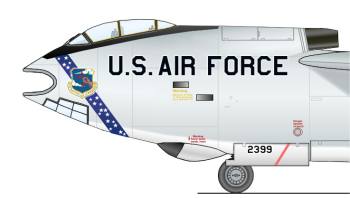
That's the Boeing Model 448. The earlier Model 432 also had engines on top of the fuselage behind the cockpit, but rather substantially further aft.
(Blatant Commercialism Mode ON) More on the 448 can be found in US Bomber Projects Preview, available here:
http://www.up-ship.com/Book/preview.htm
Attachments
- Joined
- 13 June 2007
- Messages
- 2,173
- Reaction score
- 3,095
Thanks Scott - that's the one I was thinking of.
As for my last post, please ignore my reference to the XB-51 and different design teams within Martin. I mentally swapped Martin for Curtiss when thinking of the designs. Duh, this is a Curtiss proposal model...
Enjoy the Day! Mark
As for my last post, please ignore my reference to the XB-51 and different design teams within Martin. I mentally swapped Martin for Curtiss when thinking of the designs. Duh, this is a Curtiss proposal model...
Enjoy the Day! Mark
- Joined
- 22 January 2006
- Messages
- 4,216
- Reaction score
- 2,017
Thanks for the Model 448 drawing Scott, but the mistery is still unsolved. That Curtiss design has a unique engine layout that I can recall from any aircraft design from my archive ???.
Don't worry Mark, I edited the tittle the subject from Martin to Curtiss.
As for my last post, please ignore my reference to the XB-51 and different design teams within Martin. I mentally swapped Martin for Curtiss when thinking of the designs. Duh, this is a Curtiss proposal model...
Don't worry Mark, I edited the tittle the subject from Martin to Curtiss.
Matej
Multiuniversal creator
Just a silly idea - what if its not the jet engine but turboprop and on the trailing edge are nozzles for rocket assisted take-off and/or in-flight accelerating?
pometablava said:Thanks for the Model 448 drawing Scott, but the mistery is still unsolved. That Curtiss design has a unique engine layout ...
A total of 8 engines is not *that* out of the question. These would apparently be some pretty small engines; whether this design was intended to use some off-the-shelf engiens that happened to be small, or specifically went after a large number of engines (for reliability reasons?), I can't say. This layoput would, though, fail for the same reason that the similar layout on the Boeing 448 failed: losses from "drag" of the jet exhaust on the fuselage, and unacceptable heating of the fuselage skin panels.
- Joined
- 22 January 2006
- Messages
- 4,216
- Reaction score
- 2,017
Not a bad idea, Matej, but in my opinion this "Proposal No2" is not a turboprop because forward fuselage is the same as in Model 517
Model 517 was a pure jet aircraft. The jets were placed in the wing roots. Anyway tonight I'm going to take a second look at my Model 517 and I'll post again.
Antonio
Model 517 was a pure jet aircraft. The jets were placed in the wing roots. Anyway tonight I'm going to take a second look at my Model 517 and I'll post again.
Antonio
- Joined
- 27 December 2005
- Messages
- 17,752
- Reaction score
- 26,434
Pometablava was basically correct. As per Tony Buttler, this model is a variant of the P.518, the swept wing version of the P.517 Light Bomber. 3 view, cutaway and description can be found on Page 50, American Secret Projects: Bombers, Attack and Anti-submarine Aircraft. It was powered by 8 Westinghouse 24C (J34) engines.
taildragger
You can count on me - I won a contest
- Joined
- 2 November 2008
- Messages
- 404
- Reaction score
- 502
For a while in the late 40's there was enthusiasm, in the US industry anyway, for extremely small diameter jet engines that would be used in large numbers in aircraft. They would have given designers more freedom in installation (albeit with some added complexity) and overcome the low engine reliability of the day but, as I recall, the main motivation was a belief that microjets would be inherently more efficient for geometrical reasons. The reasoning seemed flawed to me but apparently elements of the industry bought into it - for a while.
- Joined
- 3 June 2006
- Messages
- 3,094
- Reaction score
- 3,966
Wow, a topic I've never seen before. 
Stargazer,
I presume, that Overscan is updating topics in this forum with facts and figures from the book "American Secret Projects: Bombers, Attack and Anti-submarine Aircraft", after he had thoroughly read it during the last few weeks. That is also why some old topics are "resurrected from the dead".
Stargazer,
I presume, that Overscan is updating topics in this forum with facts and figures from the book "American Secret Projects: Bombers, Attack and Anti-submarine Aircraft", after he had thoroughly read it during the last few weeks. That is also why some old topics are "resurrected from the dead".
- Joined
- 9 October 2009
- Messages
- 21,976
- Reaction score
- 13,638
taildragger said:For a while in the late 40's there was enthusiasm, in the US industry anyway, for extremely small diameter jet engines that would be used in large numbers in aircraft. They would have given designers more freedom in installation (albeit with some added complexity) and overcome the low engine reliability of the day but, as I recall, the main motivation was a belief that microjets would be inherently more efficient for geometrical reasons. The reasoning seemed flawed to me but apparently elements of the industry bought into it - for a while.
On the other hand, the 1946 timeline might tend more towards the theory that those nozzles are RATO/JATO or something similar.
devoitine520
ACCESS: Restricted
- Joined
- 11 March 2006
- Messages
- 8,625
- Reaction score
- 3,806
I think it's this:
http://www.secretprojects.co.uk/forum/index.php/topic,2148.msg18229.html#msg18229 #2
Good find, the engines seem to be further aft, than in the model.
http://www.secretprojects.co.uk/forum/index.php/topic,2148.msg18229.html#msg18229 #2
Good find, the engines seem to be further aft, than in the model.
- Joined
- 25 June 2009
- Messages
- 14,754
- Reaction score
- 6,155
Jemiba said:I think it's this:
http://www.secretprojects.co.uk/forum/index.php/topic,2148.msg18229.html#msg18229 #2
Good find, the engines seem to be further aft, than in the model.
That was exactly my guess. I suppose you can merge both topics now, Jemiba.
- Joined
- 17 October 2006
- Messages
- 2,393
- Reaction score
- 1,197
- Joined
- 13 June 2007
- Messages
- 2,173
- Reaction score
- 3,095
Very nice find Papy Honda - what is the source?
Enjoy the Day! Mark
Enjoy the Day! Mark
- Joined
- 3 June 2006
- Messages
- 3,094
- Reaction score
- 3,966
Curtis P-518 from 30.03.1946
Scan source: http://forum.avionslegendaires.net/viewtopic.php?f=5&t=8069
Original source: US National Archives RG-342
Published source: American Secret Projects: Bombers, Attack and Anti-Submarine Aircraft by Tony Butler- page 49 & 50
Scan source: http://forum.avionslegendaires.net/viewtopic.php?f=5&t=8069
Original source: US National Archives RG-342
Published source: American Secret Projects: Bombers, Attack and Anti-Submarine Aircraft by Tony Butler- page 49 & 50
- Joined
- 13 June 2007
- Messages
- 2,173
- Reaction score
- 3,095
Greetings All -
A photo of one of P-517 light bomber proposal on EPay:
http://www.ebay.com/itm/12395-Photo-Curtiss-Wright-Company-Light-Bomber-Aircraft-AAF-Military-Plane-/251225816950?pt=LH_DefaultDomain_0&hash=item3a7e39bf76
http://www.ebay.com/itm/12371-Photo-Curtiss-Wright-Company-Model-Light-Bomber-P-517-Phantom-Aircraft-/400408631758?pt=LH_DefaultDomain_0&hash=item5d3a36d9ce
Enjoy the Day! Mark
A photo of one of P-517 light bomber proposal on EPay:
http://www.ebay.com/itm/12395-Photo-Curtiss-Wright-Company-Light-Bomber-Aircraft-AAF-Military-Plane-/251225816950?pt=LH_DefaultDomain_0&hash=item3a7e39bf76
http://www.ebay.com/itm/12371-Photo-Curtiss-Wright-Company-Model-Light-Bomber-P-517-Phantom-Aircraft-/400408631758?pt=LH_DefaultDomain_0&hash=item5d3a36d9ce
Enjoy the Day! Mark
Attachments
- Joined
- 27 December 2005
- Messages
- 17,752
- Reaction score
- 26,434
P-518 photos
http://www.ebay.com/itm/12374-Photo-Curtiss-Wright-Company-Model-Light-Bomber-P-518-Aircraft-1946-AAF-/400408633638?pt=LH_DefaultDomain_0&hash=item5d3a36e126
http://www.ebay.com/itm/12375-Photo-Curtiss-Wright-Company-Light-Bomber-P-518-Aircraft-1946-AAF-/400408634237?pt=LH_DefaultDomain_0&hash=item5d3a36e37d
http://www.ebay.com/itm/12375-Photo-Curtiss-Wright-Company-Light-Bomber-P-518-Aircraft-1946-AAF-/400408634237?pt=LH_DefaultDomain_0&hash=item5d3a36e37d
http://www.ebay.com/itm/12374-Photo-Curtiss-Wright-Company-Model-Light-Bomber-P-518-Aircraft-1946-AAF-/400408633638?pt=LH_DefaultDomain_0&hash=item5d3a36e126
http://www.ebay.com/itm/12375-Photo-Curtiss-Wright-Company-Light-Bomber-P-518-Aircraft-1946-AAF-/400408634237?pt=LH_DefaultDomain_0&hash=item5d3a36e37d
http://www.ebay.com/itm/12375-Photo-Curtiss-Wright-Company-Light-Bomber-P-518-Aircraft-1946-AAF-/400408634237?pt=LH_DefaultDomain_0&hash=item5d3a36e37d
Attachments
I HAVE THIS REPORT I AM ADDING TO EBAY TONIGHT .........
Attachments
- Joined
- 26 May 2006
- Messages
- 34,911
- Reaction score
- 15,789
I can't ID the original source for it ?,
Attachments
Similar threads
-
-
-
Curtiss-Wright CW- designations and P- projects
- Started by Jos Heyman
- Replies: 45
-
-
Ambrosini SAI P.303 Light Airplane Project ?
- Started by hesham
- Replies: 6

